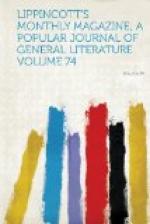[Illustration: Ridley park.]
[Illustration: Crum Lynne falls]
Gray’s Ferry is an old historic name, for here Washington and the men of the Revolution crossed again and again. The old rope ferry was succeeded by the old horse ferry, and now there are three railroads here—the Darby Improvement, the Junction (which goes to West Philadelphia and makes the connection for the great Southern Air-line), and the old line, which leads us out, through the old Bartram Gardens, where an enthusiastic botanist made the first and best collection of trees and plants in this country, on to the marshes of the Delaware. The mighty river, widening into a bay, flows on to the ocean, its bosom furrowed by thousands of keels and whitened by myriad sails. We look over wide acres of marshes, now green with the tender colors of spring, the corn-fields of the higher portion giving by their brown earth beautiful contrasts of color, the rows of corn just coming into sight. All over these meadows stand huge oak trees and elms, amongst whose branches the vessels seem to glide. But beautiful as the scene is, it is a bad place for a railroad, for when the great river rushes down swollen by some freshet, and is met by the incoming tide, the water sets back over the marshes and threatens to sweep away the track or put out the fires of the locomotives; and to cross streams and tideways many draw-bridges, with their attendant dangers, must be maintained. To avoid all these difficulties, Mr. Hinckley planned the change which is known as the Darby Improvement, carrying the road from Gray’s Ferry to Chester over and through the high lands of Darby and Ridley. We shall no longer hear the brakeman shout out “Gibson’s,” “Lazaretto,”, “Tinicum” (called by the Indians Tenecunck), “Crum Creek.” We shall no longer wonder that the train should be stopped for so few passengers to get on or off, for in future our car will take us over a road-bed so perfectly laid with steel rails that a full glass of water will not spill as the train hurries on through a thickly settled country. Look quickly from the window at the country you are traversing: see the beautiful station at Bonnaffon, and the magnificent oak tree, worth a hundred stations, that stands in a field just beyond. We cannot enumerate all the beauties and objects of interest that line the road: every valley opens a pleasant view, every hill is covered with handsome houses, comfortable farmeries or superb trees. Before the road was made, these lands, lying on a ridge high above the river, perfectly healthy and offering the most desirable homes for city people, were inaccessible, but now they can be reached, and have been already appreciated. Most of the land has grown too valuable for farming, and has been bought up and laid out with different degrees of care for suburban residences.
[Illustration: Distant view of landscape, showing military Institute at Chester.]




